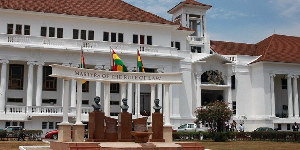Economy of Ghana: Yesterday, Today and the Way Forward
III. Unlimited Government, Unlimited Ambition: 1957-1966 By June of 1957, the five-year Plan had been ?substantially completed?, with schools, hospitals, and roads among its many accomplishments. During this period, primary education was made free and compulsory, the College of Technology in Kumasi was established, and construction of the Tema township and harbour commenced.
It is important to remember that at this point Nkrumah had nothing short of rapid industrialisation in mind, determined to prove wrong his many critics ? at home and abroad ? who doubted the possibility of industrialising the Gold Coast. Indeed, the Commission which investigated the disturbances of 1948 made the following dire assessments of the prospects of economic development in the Gold Coast? Enervating climate and lack of raw materials give barren prospect to industrialisation?.
The two years after independence in 1957 were treated as a period of ?consolidation,? learning from the experiences of the five-year plan and assessing the prospects for moving forward. In March 1959, Dr. Nkrumah presented to Parliament the Second 5-Year Plan (1959-1964) costing ?350 million, with ?100 million going into ?hydro-electric development? alone. For the first time, the government acknowledged the need to ?obtain capital from overseas? and an Investment Promotions Board ? a precursor to our current Ghana Investment Promotion Centre ? was set up to facilitate that.
At the same time the government reiterated its commitment to ?direct participation in industry and for the pioneering of various industries directly by government?. Textiles, shoes, breweries, tobacco, canning, building materials, cement, bricks and tiles, as well as lumber, were among the many industries proposed under the plan.
Significantly, in stressing the importance of social services in national development, Nkrumah made the following observation, which has an uncanny resonance to conditions not just in Accra but in cities like Kumasi, Cape Coast, and Tamale today.
The water shortage in Accra only highlights the urgent need for improving water supplies throughout the country, particularly in the rural areas.
Once again, we must ask: Wonya aloo womba? [In the so-called residential areas where I live, we are in our second month without water ? and, in typical Ghanaian fashion ? without any explanation from the Ghana Water Company.]
Like all visionaries, however, Nkrumah was a man in a hurry. Thus, in 1961, he replaced the Second Five-year Plan with the now-famous 7-Year Development Plan. Designed to provide the rudiments of an industrial economy by 1970, the 7-year Plan was costed at a whopping ?1,016 million. It was the most comprehensive and coordinated yet, based upon the expertise of economists from around the world. Not surprisingly, the Plan was the first to contain forecasts of economic growth. Significantly, the current senior minister, J.H. Mensah, was the executive secretary of the National Planning Commission, under the Chairmanship of President Nkrumah..
By now it was a commonly accepted fact that the massive infrastructure developments of the past years were being under-utilised. The 7-year plan thus focused on the productive sector, as shown below:
IV. Subversion, Regression, and HIPC: 1966-2001
Among the casualties of the 1966 coup was the 7-year plan, whose implementation was promptly suspended by the coup makers. Much has been written about what has happened in the years since then ? the general decline in the economy, our decaying infrastructure, both physical and institutional, and indeed the diminution of our very sense of being, our dignity, our self-confidence, as a people.Without spending much time on cause and effect, I?ll focus on Ghana?s per capita income since 1962 in comparison to South Korea to illustrate the scale of the meltdown of our economic fortunes since the 1960s. I chose S. Korea because Ghana?s per capita income was higher than that of South Korea in 1962 ($190 vs. $110) But by 2000, the eve of HIPC relief, our per capita income was only 4.0 percent of that of South Korea?s - $340 vs. $8,900. (This is elaborated upon in the Power Point presentation).
There are several ways of explaining this dramatic meltdown in our economic fortunes. One way is to look at the rate at which we invested in our economy for productive purposes. As stated earlier, a hallmark of our earlier development efforts was the massive investments made. Hence, in 1960, Ghana?s gross capital formation as a share of GDP was 24.4 percent, compared to 11.5 percent for South Korea (or, to extend the comparison, 9.2 percent for Indonesia; 13.7 percent for Malaysia; 15.4 percent for Thailand; and 16.7 percent for Cote d?Ivoire.)
By 1970, when S. Korea?s per capita income surpassed that of Ghana, our gross capital formation ratio had fallen to 14.1 percent while S. Korea?s had risen to 25.5 percent. By 1983, when we launched structural adjustment, the ratios were 3.7 percent for Ghana and nearly 30.0 percent for S. Korea. By the close of the century, Ghana was back where it started ? 24.0 percent ? but this was almost entirely due to donor-induced investments in the public sector. Other data, such as private sector credit, showed continued decline. In 2000, credit to the private sector in Ghana constituted about 14.percent of GDP; it was 102 percent in S. Korea.
Why the disparity? Simple. While successive S. Korean governments, including the military dictatorship of Park Chung Hee, actively worked with the private sector to promote their brand of economic nationalism, government-private sector relations in Ghana were adversarial and too often punitive and ultimately pernicious. In short, we shot ourselves in the foot. But we have a chance to redeem ourselves yet.
The paradox of the HIPC initiative is that in order to qualify for debt relief, we had to do more of the very things that got us into it in the first place, that is, to have a ?programme with the IMF.? And this programme ? starting from structural adjustment, enhanced structural adjustment, and poverty reduction and growth facility ? has had the singular effect of depressing economic growth, limiting the possibilities for national development, and deepening our dependence on external charity for everything from roads to schools to mosquito nets to public toilets. Those of you who have been to the Elmina Castle lately might have seen the garbage can at the entrance with an inscription that reminds us that it was donated by the German government. Another national shame.
Another problem with HIPC, which I hope to discuss extensively in a separate presentation, is the statistical falsehoods that were used to stampede us into it. I was at Labadi Beach hotel, with a number of government officials in 2001, when a couple of nervous Britons, sent here by the British government to convince our government about the rightness of HIPC, made their presentations on the issue ? drawing largely from IMF material. But even that couldn?t disguise the major flaws in the strategy..
Our external debt, as I said at the time, was, based on a trend-comparative analysis, for example, should have been about $10 billion higher than the $6 billion reported, given the size of our economy and its under-utilised potential. I also noted that debt levels by themselves don?t tell us much about a nation?s ability to finance its debt, and that growth and an effective and efficient tax administration offer better alternatives. A badly run economy will have difficulty financing even $1 billion debt; a well-run economy would have no such difficulty financing 20 times as much. We suffered from the former. In addition to the above, some of the indicators of debt stress were flat out misleading. To take the debt stock in December, for example, and divide it by economic activity over an entire year of 12 months is bound to distort the true extent of debt stress. And in our case, it did, pushing us further into the arms of the IMF for more misguided policy prescriptions.
If we were to do a proper cost-benefit analysis of HIPC, these would be some of the costs, in addition to the well-known benefits that have been sold to us.
V. Beyond HIPC: Rhetoric, ?Stability?, and Disaffection
With the declaration of the government?s intention in 2001 to access the HIPC debt relief initiative came a string of slogans meant to capture the government?s ideological and operational approach to growth and development. Thus we had Golden Age of Business. Property Owning Democracy. Positive Change (in chapters, I might note). Macroeconomic stability. Good governance. Yet even some of us who voted for this government now wonder if this was all rhetoric and nothing more.We don?t hear much about ?property owning democracy? these days. The cynical among us would say that it?s been replaced with a ?property grabbing oligarchy? (a government of the few for the few). ?Positive change? died off gradually but was revived during the 2004 campaign only for it to relapse into oblivion after the elections. We continue to hear about ?good governance? but more in style than in substance. The passage of laws and the assignment of roles among public institutions at the national and local levels may facilitate governance, but that does not by itself constitute ?good? governance ? in the broad sense used in development economics. From an economic development standpoint, we have good governance only when government does what it is expected to do, and what it says it would do, to enhance the material and non-material well-being of the people. Period.
Hence, if, for instance, you are paying increasingly more for water and electricity ? two critical services for economic and social development ? but the quantity and quality of these services are either stagnating or even declining, you have not good governance but bad governance. The microeconomist would tell you that both individual and social welfare are declining. The recent crisis in water provision as well as the worsening sanitation situation across the country, despite the fact that government takes money from us ostensibly to provide these services, are all evidence of the persistence of bad governance in the country. Let no one convince you otherwise. Some of you might be familiar with the story of the AMA tax collector who took in ?12 million but reported only ?120,000 (1%)! Now, that?s worse than bad governance. That?s criminally bad governance!. Interestingly enough, the mayor?s response to this crime was to refer the matter to the courts and then contemplate ?privatising? revenue collection, rather than fixing the rot as any good and progressive leader would and should do. It seems that privatisation has become a convenient cover for capitulation: Whenever you face a problem that you can?t or don?t want to solve, just yell, ?privatisation? and presto! all your problems would be solved. How facile can we get.
We are now left with two slogans ? macroeconomic stability and golden age of business. And here, too, the picture is mixed at best, grim at worst. Most of the data in the government?s own policy documents regarding the economy are either flat out wrong or selective in their representation of the economic and social realities of the country.
As shown in the Power Point Presentation, figures presented in the 2003 budget as depreciation rates of the cedi, for example, were actually the appreciation rates of the dollar; embarrassingly, the same mistakes are repeated in the Growth and Poverty Reduction Strategy II, whose implementation is expected to commence this year. Shockingly, when the government met its ?development partners? in November 2005 to solicit funding for the GPRS-II, a senior government official kept telling them ?not to worry about the technical quality? of the document but concentrate instead on how much money they could give us!. It?s like telling your architect not to worry about the structural integrity of your building, but concentrate on how much the building would cost! We should do better than that.
And even where the statistics are accurate, they provide a grim picture indeed. Page 46 of the 2006 budget, for example, shows a decline in the private sector?s share of outstanding credit from commercial banks, despite the ?golden age of business.? Significantly, credit for import trade increased while that of manufacturing declined. In the same vein, successive reports on the state of the Ghanaian economy by ISSER, University of Ghana, have shown declines in business registration and in foreign direct investment. Although there?s been a modest recovery in FDIs, the levels are still lower than they were in 1999, the year before the economic crisis that eventually led to HIPC.
As a footnote, it must be noted that contrary to popular claims ? and perceptions ? the annual inflation rate between 1997 and 2000 was 20.0 percent, while the rate between 2001 and 2004 average 22.0 percent. Clearly, inflation did NOT decline after 2000, as we?ve been made to believe, but it actually went up. Similarly, while the rate of depreciation of the cedi against the dollar has declined dramatically ? from about 50.0 percent in 2000 to around 2.0 percent in 2005, the inflation rate has also been higher than the depreciation rate.
This has had the effect of making Ghana?s exports uncompetitive, as evidenced by the steady decline in merchandise exports as a share of GDP from 37.0 percent in 2000 (having rising from 25.8 percent the previous year) to 32.0 percent in 2004. Indeed, according to GPRS-II, the share of manufacturing as well as water and electricity in GDP, all indicators of private-sector activity, have declined steadily since 2001, in addition to a fall in the fisheries sector?s share, despite the appointment of a minister of fisheries by the current government. Something ain?t right.
What then, one is tempted to ask, has been the source of the much-vaunted macroeconomic stability? If we look at the external component of that stability, such as increased international reserves, the answer simply is ?luck?. For example, between 1997 and 2000, prices of cocoa beans on the world market declined by an annual average of 4.4 percent; they increased by 13.4 percent between 2001 and 2004. Gold prices declined by 7.5 percent in the first period but increased by 10.3 percent in the second. At the same time, oil prices rose at an annual average of 19.3 percent in the first period but slowed down to 6.4 percent in the second period. Unrequited private transfers have also increased. (This is elaborated upon in the presentation).
Suffice it to say that the social upshot of what is going on on the economic front has been one of growing public disaffection, as evidenced by the government?s Core Welfare Indicators Questionnaire (CWIQ) survey in 2003. According to the survey, 51.5 percent of Ghanaian households felt that their living conditions in 2003 were ?worse? than they were the previous year; only 27.0 percent said things were ?better.? A later study by the Centre for Democratic Development corroborated these findings in even greater detail.
... to be continued
In Observance of the 49th Independence Day of Ghana
Organised by: Patriots of Convention People?s Party (CPP) and Youth for Action, University of Cape Coast
University of Cape Coast Auditorium

Views expressed by the author(s) do not necessarily reflect those of GhanaHomePage.














